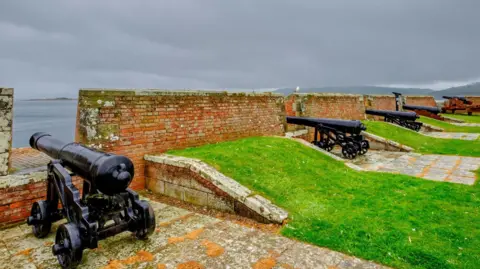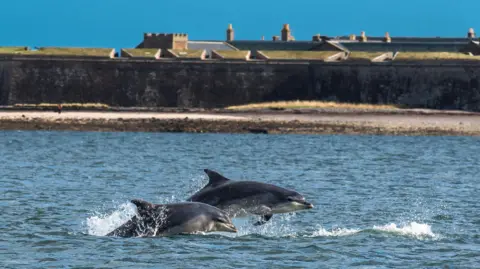Sink hole at historic fort risks sea wall collapse
 Getty Images
Getty ImagesPart of historic Fort George in the Highlands is at risk of collapsing into the sea due to a sink hole.
The artillery fortification was constructed on the Moray Firth, near Inverness, after the Battle of Culloden more than 250 years ago and it is run today as an army base and visitor attraction.
Historic Environment Scotland (HES) describes the site as the "finest example" of 18th Century military engineering in the British Isles.
However, it has warned a hole has appeared behind a sea wall and emergency repairs are required.
HES, which has applied for planning permission for the work, said it was monitoring the damage.
It added that public access to the fort was unaffected.
 Getty Images
Getty ImagesIn a report supporting its planning application to Highland Council, HES said a sink hole had opened in the ground behind an area called the North Glacis retaining sea wall.
The emergency work would involve pouring concrete to a depth of about 1.5m (5ft) to fill the hole and support the wall.
The report said: "Without immediate intervention, there is a significant risk of catastrophic collapse of the sea wall and considerable loss of historic fabric."
HES told BBC Scotland News coastal erosion had lowered beach levels along the Moray Firth.
It said it had previously dealt with issues at Fort George in an area known as the Dog Cemetery, where there are the graves of regimental mascots and officers' pets.
A spokesperson said: "Concrete underpinning works took place in late 2024 which allowed for our stonemasons and labourers to safely carry out localised repairs to the existing stone wall and associated landscaping.
"These works were completed by the end of 2024 and access to the Dog Cemetery has since been reinstated to the Ministry of Defence."
HES said a small area of the North Glacis had since been fenced off.
The spokesperson added: "Remedial works are planned and full access will be reinstated on the North Glacis once these have been completed."
Fort George was built near Ardersier by the British government after 1746's Battle of Culloden, which saw forces led by Bonnie Prince Charlie defeated by government troops.
The fort took 22 years to complete.
It was a symbol of the Crown and was given the resources to crack down on fresh Jacobite rebellions, or risings.
The fort had capacity for a garrison of 1,600 infantrymen with access to numerous cannon, muskets, pikes and swords.
The magazine - a weapons store - could hold 2,500 gunpowder barrels and there were also provision stores and a brew house.
During World War Two, Fort George was a base for tank crews and their armoured vehicles while training for D-Day.
The tanks would run on the roads from the fort to Burghead in Moray for training on beaches there.
Today it serves as a base for the Black Watch, 3rd Battalion, The Royal Regiment of Scotland.
HES manages large parts of the site as a visitor attraction.
